The California culture area has the widest variety of native languages, ecological settings, and house types of any North American culture area.
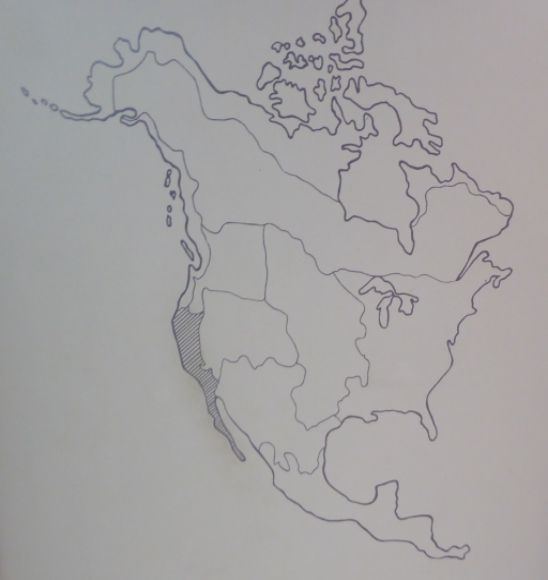 The shaded area on the map shown above displays the California culture area.
The shaded area on the map shown above displays the California culture area.
Basketry was, and still is, important to the California Indians. In his book Indians of Lassen Volcanic National Park and Vicinity, Paul Schulz puts it this way:
“The outstanding art of the Indians of California was their basketry. In fact the excellence of California basketry generally is not exceeded elsewhere in North America.”
Two basic methods of basketry are used. The first of these is twining in which a heavy foundation is made from the center to the rim of the basket. A woof of lighter material is then woven through the foundation. By working with two strands of material simultaneously, alternating above and below each other, the weaver can hide the basket’s foundation. Twined baskets are usually quite flexible.
The second form of basketry used by the California tribes is coiling. In making this type of basket, the heavy foundation is laid in horizontal coils with filling run spirally around the heavy foundation. Coiled baskets are usually fairly rigid.
 The openwork baskets shown above may be Yurok, Hupa, or Karok.
The openwork baskets shown above may be Yurok, Hupa, or Karok.
 The baskets shown above were probably made for sale. They appear to be Yurok, Karok, or Hupa. The basket with the hooded opening is unusual and the purpose of this shape is not known.
The baskets shown above were probably made for sale. They appear to be Yurok, Karok, or Hupa. The basket with the hooded opening is unusual and the purpose of this shape is not known.

 Shown above are two hoppers made by Yurok, Karok, or Hupa weavers. Acorns were traditionally ground with a stone mortar and pestle to make flour. The basketry hopper was used to keep the flour from spilling out of the mortar and was sometimes attached to the mortar with pitch.
Shown above are two hoppers made by Yurok, Karok, or Hupa weavers. Acorns were traditionally ground with a stone mortar and pestle to make flour. The basketry hopper was used to keep the flour from spilling out of the mortar and was sometimes attached to the mortar with pitch.
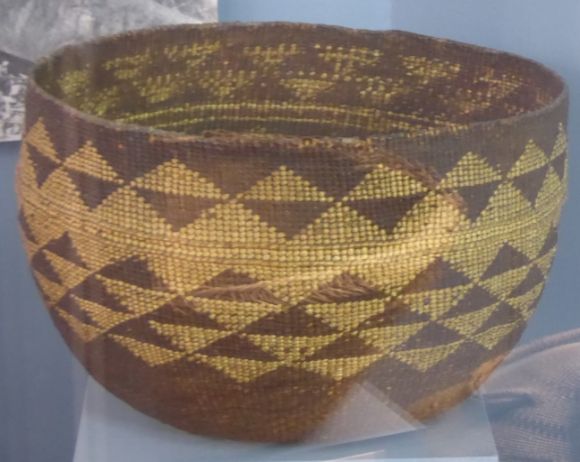 Shown above is a mush bowl made by Yurok, Karok, or Hupa weavers.
Shown above is a mush bowl made by Yurok, Karok, or Hupa weavers.
According to the Museum description:
“Mush made from acorn meal was cooked and served in basketry bowls. Acorns were ground into flour, then mixed with water, and hot stones were dropped into the basket to cook the mush. As they cooled, the stones were removed and more were added. They were stirred to keep them from burning the bottom of the basket.”
Yokuts or Tulare
The traditional territory of the Yokuts was in Central California along the San Joaquin River Valley and the foothills of the Sierra Nevada. With regard to Yokuts basketry, Carl Waldman, in his book Encyclopedia of Native American Tribes, writes:
“The Yokuts made exquisite baskets, coiling thin bundles of grass stems upward in a spiral and binding them with marsh grass.”
In his monumental 1925 work, Handbook of the Indians of California, A.L. Kroeber (1976: 531) writes:
“Yokuts baskets are distinguished by one special type, a coiled jar-like vessel with flat shoulder and constricted though sometimes flaring neck. The pattern is one or more bands in red and black, either diamonds or hexagons or alternative trapezoids.”
According to the Museum display:
“These flared wide-mouthed bowls are typical of basketry made by the Yokuts and Tulare. Made in a variety of sizes, these coiled baskets were sometimes ornamented with geometric patterns, or sometimes with human figures incorporated in the design.”



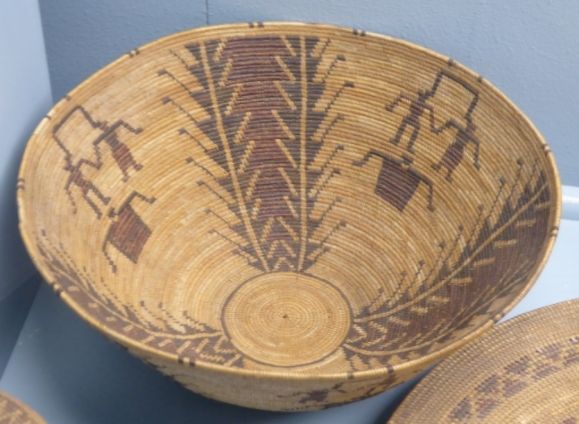
Shasta
The traditional Shasta homelands were along two of the southern tributaries of the Klamath River: the Scott River and the Shasta River.
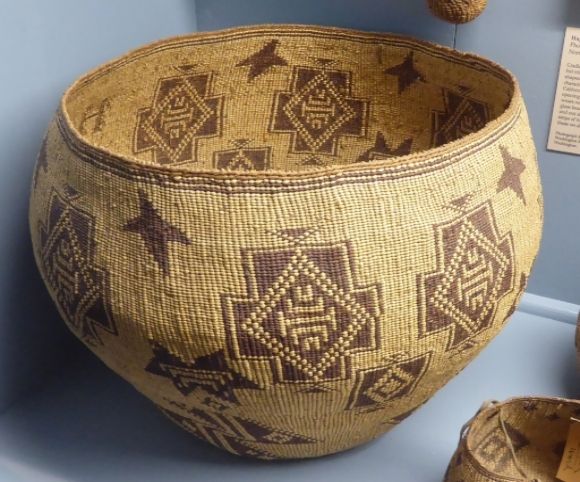 Large baskets, such as the one shown above, were used for storing food supplies.
Large baskets, such as the one shown above, were used for storing food supplies.
Klamath
The Klamath occupied a territory on the present-day California-Oregon boundary.
 The yellow designs on this twined bowl are made from dyed bird quills.
The yellow designs on this twined bowl are made from dyed bird quills.
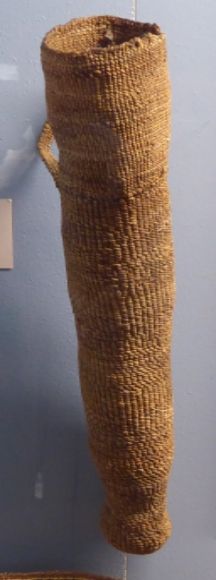 Shown above is a quiver.
Shown above is a quiver.


Twined basketry trays were used to catch acorn meal as it was sifted, and for serving salmon.
 The designs on the twined basket shown above represent the top knot of the California quail.
The designs on the twined basket shown above represent the top knot of the California quail.
Hupa
The aboriginal territory of the Hupa (also spelled Hoopa) was along the Trinity River in Northern California. The Hupa are closely related to the Karok and Yurok.
 Shown above are a baby carrier (on right) and a model baby carrier. During the first two years of life, a child needed three or four cradles.
Shown above are a baby carrier (on right) and a model baby carrier. During the first two years of life, a child needed three or four cradles.
Chumash
The aboriginal territory of the Chumash was in the vicinity of present-day Santa Barbara, California. Their territory included three of the eight Channel Islands. With regard to language, Chumash belongs to the Hokan language family.
 Shown above is a Chumash coiled tray which was used for winnowing and parching seeds.
Shown above is a Chumash coiled tray which was used for winnowing and parching seeds.
According to the Museum display:
“The Chumash were well known for their finely woven basketry from a very early period. The early Spanish explorers and settlers admired and collected their baskets.”
Monache (Mono)
The Mono (also known as Monache) homeland was the area near Mono Lake.
 Shown above is a Monache winnowing tray.
Shown above is a Monache winnowing tray.
According to the Museum display:
“Piñon pine nuts and seeds were staple foods among the tribes along the eastern border of California. This type of twined openwork tray was used to winnow pine nuts which had to be separated from their cones and shells.”
Indians 101
More about Native American baskets from this series:
Indians 101: Arctic Baskets (Photo Diary)
Indians 101: Klikitat Baskets (Photo Diary)
Indians 101: Pomo Indian Baskets (Photo Diary)
Indians 101: California Women's Woven Hats (Photo Diary)
Indians 101: Plateau Indian Basket Hats and Trinket Baskets (Photo Diary)
Indians 101: Southwestern Baskets in the Maryhill Museum (Photo Diary)


